Last round for this month and an enjoyable, but, in my opinion, a strange game.
I played far too passively in the opening, and did not take advantage of Black's many initial pawn moves.
Not to say that I played badly. I developed pieces, had a plan, and generally felt good about it, but if I had been more active, I feel I was in a fine position to take advantage.
Probably my first slow-time French Defence, although it was a roundabout way to reach it.
Black initially played many pawn moves to gain space and initiate a Queen-side advance, but missed an obvious threat, lost a pawn and ,as I had pieces in the right places, I was able to create a second weakness and exploit it, leading to further material gain.
This was classed as a French Defence, not something that I play against very often, although when faced with it before, I have resorted to playing the King's Indian Attack.
I think 3...c6 is not the normal move order, and although it seems to prepare d5 strongly, Black in fact played d6 and only later d5, so surely a wasted move ?
In fact of his first 10 moves, 6 were with pawns, compared to my 4, so although I may not have been following "French Defence" lines, I have more pieces developed, in more 'natural' places, I've castled, and am restricting Black's king-side ( ie his Knight and Bishop) significantly : all looks good.
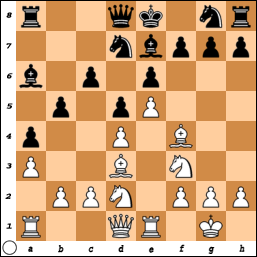 [10...Ba6]
[10...Ba6]
At this point, my plan was to advance on the Queen-side, forcing Black back and gaining space. Preventing this was the bishop on e7, as well as a bit more fire-power. Moving the Q to c2 provides additional support as well as threatening h7.
Here is the first mistake. Black misses the threat, and loses a pawn on h7. I calculated that BxN was good, but preferred Bg5, which prevents castling, and probably prompts Ne7, blocking the bishop and allowing b3 to start a 'second front' on the Queen-side.
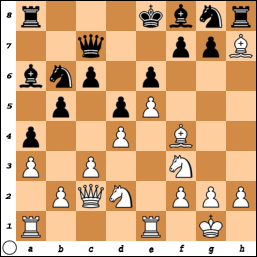 [Black has played 13...Qc7] Should White take the Knight ?
[Black has played 13...Qc7] Should White take the Knight ?
White needs to extricate the Bishop to prevent it being trapped by g6, and Black now castles ( Nc4 would have been better), which allows White to play b3 and execute his plan.
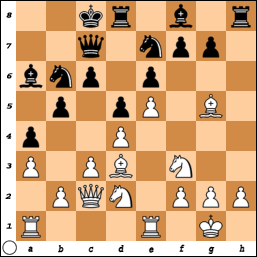 [Black has played 15.0-0-0]
[Black has played 15.0-0-0]
16.b3 gives White a definite plus, and it was pleasing to see an envisaged plan carried through in this way.
If Black plays 16...ab, there follows 17.Nxb3 Na4 18.Nc5 Nxc5 19.dc and with the more active pieces, as well as the material advantage, White has a definite advantage.
In the event Black plays 16...Kb7, then 17.ba Nxa4 18. Rab1 followed by the strange Rb8 from Black which loses the Knight to 19.Qxa4, as the pawn is pinned to the King. White is ahead material and with a good position and attack.
19....Kc8 is not forced, I think, and better would have been Ka7, which defends the bishop.
However, I could not calculate clearly enough, and backed out of Qxa6. Further analysis shows that this is perfectly sound, as the Queen is not trapped ( Rb6, allows Qa5 and she can escape ).
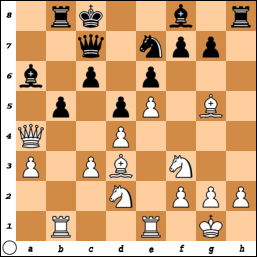 [Black has played 19..Kc8] Should White take the Bishop ?
[Black has played 19..Kc8] Should White take the Bishop ?
The game continued for some time but was not in doubt as far as I was concerned. I had enough time and material.
Black avoided mate with 31...Rxb5, but with this further loss, the end was much closer.
Eventually he resigned after 38...Kb6 left his final rook en prise, but there was actually a mate in two on the board !
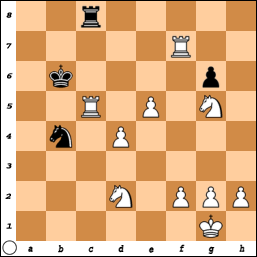 [White to play : Mate in 2]
[White to play : Mate in 2]
Regardless, a win, a good 6th position and a prize for finishing as the best Under 1700 in the Open ! Two months ICC membership seems an excellent payback for three enjoyable games.
Here's to next month !
01 April, 2010
Monthly Standard March ( Round 4 ) : A Prize win !!
Posted by Signalman at 06:01
Labels: French Defence
Subscribe to:
Post Comments (Atom)

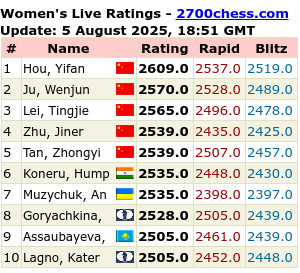
0 comments:
Post a Comment